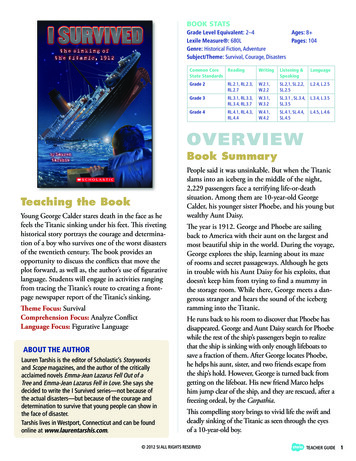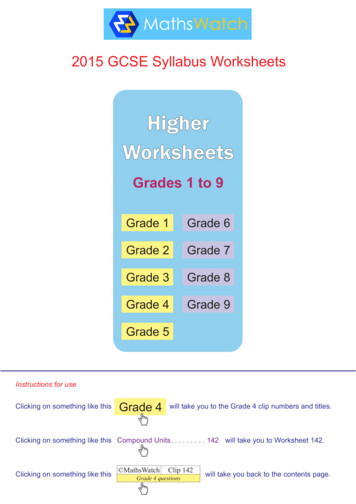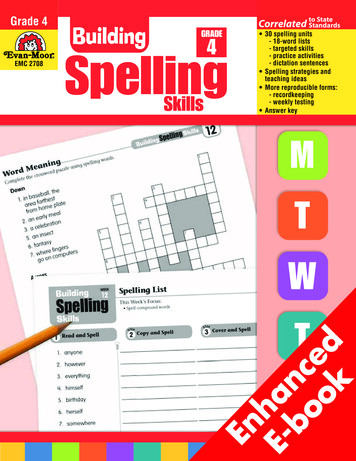
Transcription
BOOK STATSGrade Level Equivalent: 2–4Ages: 8 Lexile Measure : 680LPages: 104Genre: Historical Fiction, AdventureSubject/Theme: Survival, Courage, DisastersCommon CoreState StandardsReadingWritingListening &SpeakingLanguageGrade 2RL.2.1, RL.2.3,RL.2.7W.2.1,W.2.2SL.2,1, SL.2,2,SL.2.5L.2.4, L.2.5Grade 3RL.3.1, RL.3.3,RL.3.4, RL.3.7W.3.1,W.3.2SL.3.1 , SL.3.4,SL.3.5L.3.4, L.3.5Grade 4RL.4.1, RL.4.3,RL.4.4W.4.1,W.4.2SL.4.1, SL.4.4,SL.4.5L.4.5, L.4.6OVERVIEWBook SummaryTeaching the BookYoung George Calder stares death in the face as hefeels the Titanic sinking under his feet. This rivetinghistorical story portrays the courage and determination of a boy who survives one of the worst disastersof the twentieth century. The book provides anopportunity to discuss the conflicts that move theplot forward, as well as, the author’s use of figurativelanguage. Students will engage in activities rangingfrom tracing the Titanic’s route to creating a frontpage newspaper report of the Titanic’s sinking.Theme Focus: SurvivalComprehension Focus: Analyze ConflictLanguage Focus: Figurative LanguageABOUT THE AUTHORLauren Tarshis is the editor of Scholastic’s Storyworksand Scope magazines, and the author of the criticallyacclaimed novels Emma-Jean Lazarus Fell Out of aTree and Emma-Jean Lazarus Fell in Love. She says shedecided to write the I Survived series—not because ofthe actual disasters—but because of the courage anddetermination to survive that young people can show inthe face of disaster.Tarshis lives in Westport, Connecticut and can be foundonline at www.laurentarshis.com.People said it was unsinkable. But when the Titanicslams into an iceberg in the middle of the night,2,229 passengers face a terrifying life-or-deathsituation. Among them are 10-year-old GeorgeCalder, his younger sister Phoebe, and his young butwealthy Aunt Daisy.The year is 1912. George and Phoebe are sailingback to America with their aunt on the largest andmost beautiful ship in the world. During the voyage,George explores the ship, learning about its mazeof rooms and secret passageways. Although he getsin trouble with his Aunt Daisy for his exploits, thatdoesn’t keep him from trying to find a mummy inthe storage room. While there, George meets a dangerous stranger and hears the sound of the icebergramming into the Titanic.He runs back to his room to discover that Phoebe hasdisappeared. George and Aunt Daisy search for Phoebewhile the rest of the ship’s passengers begin to realizethat the ship is sinking with only enough lifeboats tosave a fraction of them. After George locates Phoebe,he helps his aunt, sister, and two friends escape fromthe ship’s hold. However, George is turned back fromgetting on the lifeboat. His new friend Marco helpshim jump clear of the ship, and they are rescued, after afreezing ordeal, by the Carpathia.This compelling story brings to vivid life the swift anddeadly sinking of the Titanic as seen through the eyesof a 10-year-old boy. 2012 SI ALL RIGHTS RESERVEDTEACHER GUIDE1
Get Ready to ReadPre-Reading ActivitiesExploring the Titanic Ask students what they knowabout the Titanic. To build their background knowledge about this historic disaster, project the “FactsAbout the Titanic” from the back matter of the book(pages 99–101) on a whiteboard or screen. Ask different volunteers to read the facts, one at a time.If you want to show students visuals of the Titanic,the wreck, and the aftermath, go to History.com forits thorough, interactive coverage. Show students atour of the ship, the animated video of the impactwith the iceberg, and the rescue of the passengers byvisiting: http://bit.ly/Zkz53h.Preview and Predict Ask students to study the illustration on the cover of the book. What momentdoes the illustration picture? Where are some of thepassengers? Who might be the boy at the foregroundof the picture?STORIA ENRICHMENTSThis Storia e-book has the following enrichments toenhance students’ comprehension of the book. Word Scramble (2) Do You Know? Word Twister (2) Who Said It?VocabularyFigurative Language While most of the bookis written in spare and straightforward language,author Lauren Tarshis punctuates her descriptionsof life on the Titanic with dramatic metaphorsand similes. Remind students that a metaphor is acomparison between two unlike things. A simile isa comparison between two unlike things using likeor as. Both figures of speech create a surprising ordistinct picture in readers’ minds.Distribute copies of Resource #1: Language Cardson page 7 to students.2TEACHER GUIDEAsk students what is being compared in the firstmetaphor that appears on page 3 of the story. Howdoes the metaphor help describe what George heard?“Even more terrible sounds filled the air. . . . Abellowing sound, like a giant beast dying aterrible death.”Clarify that the author is describing what Georgehears as the Titanic is sinking. She compares the bellowing sound of the ship taking on water to a giantbeast dying a terrible death. Ask students to imaginethis sound as they look at the illustration of the shipsinking on the cover. Then tell students to watch forother examples of metaphors and similes as they readand to use the text to understand the comparisons.BIG QUESTIONCritical Thinking Ask students tothink about this question as theyread and to be ready to answer itwhen they have finished the book.Write the question on chart paperor have students record it in theirreading journals.How will George survive thesinking of the Titanic?As You ReadReading the BookModeled Reading Read aloud pages 1–3 from thefirst chapter of the book, asking students to followalong. Then prompt them to ask and answer questions about the read-aloud. For example: When doesthis scene take place? Where does it take place? Fromwhose point of view is the story being told?
Independent Reading Assign students to read ISurvived the Sinking of the Titanic independently. Before they begin, read aloud the time and place thatthe action in Chapter 2 begins. Explain that this is aflashback in time from Chapter 1.Comprehension FocusAnalyze Conflict Explain to students that a plotis the series of events in a story. For the plot to beexciting and interesting, it must have conflicts thatcause the action to rise and fall as the story proceeds.Conflicts are between a person and another person,between a person and nature, or between a personand society. Conflicts are also between a person andhimself or herself. When a conflict ends, it is calledthe resolution.Use the graphic organizer on page 8, Resource #2:Analyze Conflict to model for students how toanalyze the conflicts in the book. Project the page ona whiteboard or pass out copies to students.Model: What conflict does George face at thebeginning of the story? He is in trouble becausehe slid down the railing of the grand staircase onthe Titanic and shocked the other passengers.His Aunt Daisy is upset because he broke therules of society. So, I’ll write down that this conflict is between George and society. It is resolvedby George saying he will behave in the future.Guide students to fill in the organizer by reading theconflict, deciding who the conflict is between, andwriting how the conflict is resolved. Explain thatanswers may vary since some conflicts involve morethan one group and are resolved in more than oneway. Encourage students to share their answers anddiscuss them.After You ReadQuestions to DiscussLead students in a discussion of these focus storyelements.1. Historical Fiction How does the author revealthat the time period of the setting is 1912? Howdo people in the story dress differently than theydo today? How do George and Phoebe act differently than kids do today? What other clues in thestory tell you that the year is around 1912? (Sampleanswers: Women and girls wear long dresses and fancyhats. George talks about the New York Giants baseballteam. People cross the Atlantic on big ships.)2. Analyze Conflict What is the conflict betweenGeorge and his father at the beginning of the book?How is that conflict resolved by the end of the book?What does George learn about his father and himself?(Sample answers: George disappoints his father by notgetting good grades and getting into trouble. This maybe because they both miss George’s mother. At the end,George realizes he is like his father and his father realizeshow much he loves George after almost losing him.)3. Figurative Language Choose a character orevent from the book and describe it by creating anoriginal metaphor or simile. Write a sentence thatdraws a comparison. Then explain what characteristics you are comparing. (Sample answer: The icebergcut through the Titanic’s hull like a frozen dagger.)WORDS TO KNOWFigurative LanguagePass out copies of Resource #1: LanguageCards. Read each metaphor and ask studentsto refer to the corresponding page numbersof the book. Discuss the meanings of themetaphors and similes with the class. Thenask students the following questions:Is the figure of speech a metaphor or asimile?What two things are being compared?Do you think it is an effective metaphoror simile? Why or why not?Encourage students to record and shareother examples of figurative language fromthe book.TEACHER GUIDE3
Questions to ShareEncourage students to share their responses with apartner or small group.1. Text-to-Self What do you think your plan of action would be if you were on the Titanic?2. Text-to-World There were only 16 lifeboats onthe Titanic. Women and children from the top deckswere saved first. Do you think this would happentoday? Why or why not?3. Text-to-Text The story is told through the point ofview of George, a 10-year-old boy. How would it havebeen a different story if told through the point of viewof Aunt Daisy, or the captain of the ship, or Marco?Extension ActivitiesReading/Writing ConnectionWhat Do You Think? Reread the text about Robert Ballard and the Titanic wreck on page 101 withstudents. Ask students questions about their opin-ions of the piece such as: Do you think the Titanicshould be brought to the surface or left in peace?Why do you think this? Discuss their differentopinions about the issue. Then have students writean argument paragraph about the question. Directthem to state their opinion or claim, and to back itup with at least three reasons.Don’t forget theBIG QUESTIONCritical Thinking Give each student anopportunity to answer the big question.Encourage students to support theiranswers with details and evidencefrom the text. Remind them that thereis more than one right answer.How will George survive thesinking of the Titanic?Content Area ConnectionsEngineering How Ships Float Challenge studentswith an interest in STEM (Science, Technology, Engineering, and Math) to research how large ships like the Titanic,weighing almost 50,000 tons, are able to float. Ask themto report their findings to the class, using graphic aids toexplain the science behind buoyancy.Geography The Titanic’s Voyage Ask students to research the route the Titanic took on its one and only voyage.History.com has a detailed map showing the iceberg fieldand the route at http://bit.ly/UGvi8y. Ask students to reporttheir research by drawing the Titanic’s route including itspoint of departure and destination, the iceberg field, where itsank, and the location of the Carpathia. If possible, have students show the route using a whiteboard and Google Earth.Music Oh, They Built the Ship Titanic . . . Thistraditional song about the Titanic has long been a favoritescouting, camping, and bus-riding group song. Students willenjoy singing it again or learning it for the first time. Becauseit belongs to the folk tradition, there are many different4TEACHER GUIDEvariations, several of which can be found on the Internet.Two with music and video accompaniment are found athttp://bit.ly/Z2NTo0 and http://bit.ly/UVLcRc.History Finding the Titanic The Titanic made theheadlines again in 1985 when explorer Robert Ballard discovered the wreck of the ship at the bottom of the ocean. Providestudents with book or web resources to learn more about theremains of the Titanic and what is happening to those remains.B I G AC T I V I T YExtra, Extra, Read All About It! Have students act asjournalists and write a front-page story about the sinking ofthe Titanic. Show them some actual front pages from the timeby visiting the Huffington Post at http://huff.to/W0s3jb.Make copies of the Big Activity: Extra, Extra, Read AllAbout It! on page 5 and distribute to students. Explain thedifferent parts of a newspaper front page: newspaper name,big headline, dateline, article, and photographs or illustrations. Post the students’ front pages in the classroom.
Name:Date:Date:Name:BIG ACTIVITY: Extra, Extra, Read All About It!Createof ofthetheTitanic.Create aa rtthethesinkingsinkingTitanic!NEWSPAPER NAME:HEADLINE:ARTICLE:DRAWING OR MAP:CAPTION: 2012 SI ALL RIGHTS RESERVEDTEACHER GUIDE5
READ MORE AND LEARN MOREUse these books and other resources to expand your students’ study of the book or theme.Author/Series ConnectionsI Survived #2: I Survived the SharkAttacks of 1916Lauren TarshisAges: 8–10Grades: 2–4Lexile Measure : 610LPages: 112It’s the summer of 1916, and Chet Roscow is just as captivated as everyone else along the Jersey Shore by the localnews. A great white shark has been attacking and killingpeople up and down the Atlantic coast, not far from Chet’shometown of Springfield, New Jersey. Then one day, swimming with his friends, Chet sees something in the water. . . .This thrilling second book in the I Survived series will keepreaders turning pages to find out Chet’s fate.Available as a Storia e-bookI Survived #3: I Survived HurricaneKatrina 2005Lauren TarshisAges: 8–10Grades: 2–4Lexile Measure : 590LPages: 112Hurricane Katrina is headed for New Orleans, pushing apowerful storm surge toward the low-lying city. Barry’s family knows the storm is coming, but his little sister is criticallyill, and they can’t risk evacuation. At first it seems that theNinth Ward will be safe. But when the levees are breached,the rising waters sweep Barry away from his family. Theairwaves are calling it the Storm of the Century . . . and ifBarry is to survive it, he’ll have to survive it alone.Available as a Storia e-bookI Survived #4: I Survived the Bombing ofPearl Harbor 1941Lauren TarshisAges: 8–10Grades: 2–4Lexile Measure : 620LPages: 112Eleven-year-old Danny Crane is alone on his favorite beachin Hawaii when World War II officially hits the UnitedStates—and his world is torn apart. Now he must find thecourage to make his way home in the midst of the bombs,the smoke, and the destruction of a day that will live ininfamy! Available as a Storia e-bookI Survived #6: I Survived the Attacks ofSeptember 11, 2001Lauren TarshisAges: 8–10 Grades: 2–4 Pages: 112On the morning of September 11, Lucassneaks into Manhattan and heads down to the firehouse ofLadder Company 177. He wants to talk to his Uncle Benny,his father’s best friend and fellow firefighter. But as Lucasand Uncle Benny stand outside talking, a plane flies lowoverhead—and soon nothing will ever be the same again.As the plane hits the World Trade Center tower, the menof Ladder 177 swing into action. And when another planehits the second tower, Lucas can’t wait around the firehouseany longer—he’s got to go find his dad. He starts walkingdowntown—right toward the burning towers.Available as a Storia e-bookTheme ConnectionsTitanic: Voices from the DisasterDeborah HopkinsonAges: 9–13Grades: 4–7Lexile Measure : 1040LPages: 304Weaving together the voices of Titanic survivors and witnesses of the disaster, critically acclaimed author DeborahHopkinson brings the horrors of that terrible voyage to lifefor today’s students. Readers will meet various passengersand crew members—from nine-year-old Frankie Goldsmithto the brave seaman William Murdock. The book includesphotos of the ship and its passengers; a glossary, timeline,and survivor bios and letters; and tips on how to be a Titanicresearcher. Available as a Storia e-bookTo find PDF versions of the Storia teacher guidesand links to purchase the related books, rces/.6TEACHER GUIDEMiracle PetsAllan ZulloAges: 8–10Grades: 3–6Lexile Measure : 1050LPages: 128Guided Reading Level: SHave you ever heard about the dachshund that was snatchedup by an eagle, but fought back in midair? Or about the twopigs that escaped from a sausage factory, leaped into an icyriver, and swam to safety? And what about the pet cat whowas trapped for two months under the concrete floor of anew building under construction? Inside this riveting book,readers will find these and more incredible true tales of braveanimals who overcame life-threatening situations.Available as a Storia e-book
Resource #1: Language CardsEven more terrible sounds filled theair. . . . A bellowing sound, like a giantbeast was dying a terrible death. (p. 3)The wood was so shiny and polished,curving around like a ride at the fair.(p. 13)“I’m not letting you out of my sight,”she announced. . . . ”I’m your guardianangel.” (p. 17)Thinking about Mama was likestanding close to a fire. Warm at first.But get too close and it hurttoo much. (p. 41)The cat dropped the branch and cameafter him, like a shadow with glowingeyes. (p. 31)The shaking got stronger andstronger, the noise louder and louder,like thunder exploding all around them.(p. 39)People fell, toppling like dominoes.(p. 61)The water was so cold it felt likemillions of needles were stabbing him.(p. 74) 2012 SI ALL RIGHTS RESERVEDTEACHER GUIDE7
Name: Date:RESOURCE #2: Analyze Conf lictIdentify each conflict. Is it person vs. person, person vs. nature, person vs. society, or person vs.self? Then write how the conflict is resolved.Story Conflict8Conflict BetweenGeorge gets in trouble forsliding down staircase.vs.George meets scar-faced man inbaggage room.vs.George has to get his family andfriends out of the bottom deckbefore it floods.vs.George has to find the courage tosave himself from sinking ship.vs.George survives icy waters andhelps Marco into boat.vs.TEACHER GUIDE 2012 SI ALL RIGHTS RESERVEDResolution of Conflict
edge about this historic disaster, project the "Facts About the Titanic" from the back matter of the book (pages 99-101) on a whiteboard or screen. Ask differ-ent volunteers to read the facts, one at a time. If you want to show students visuals of the Titanic, the wreck, and the aftermath, go to History.com for











